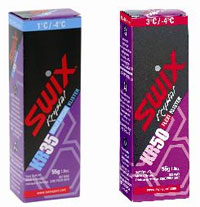
Klister Cushion?
Tue, Feb 1, 2011 - By Chris Hall
 Using hard wax, we often do a hard-over, putting the softer wax underneath as cushion and using the colder on top so it doesn't ice, and then might wear away as the day warms, snow gets warmer.
Using hard wax, we often do a hard-over, putting the softer wax underneath as cushion and using the colder on top so it doesn't ice, and then might wear away as the day warms, snow gets warmer.
Is the same process ever used with klister? We have a 26K race that basically does the Gold Rush course this weekend, starting cold, going up high, but ending in warmer snow. Would putting a layer of KR40 OVER Universal be something that would work, or does putting a harder klister over a softer one lead to problems?
Using the method for hard wax is proven and definitely works. It works mainly because you do not need to use heat (ie-heat gun or torch) when applying hardwax covers. So, one is able to cover or "shell" a colder hard wax over a warmer hard wax without mixing them, provided they are careful when corking and smoothing the cover layer.
I would be very hesitant to try the combination of a harder klister over a softer one. I think the biggest issue would be that the two will end up being mixed anyway because of the necessary heat needed to smooth the KR40 over the K21n or K22n for example. Also, I think that the KR40 might not wear as much as it is needed to over the lower and colder part of the course and the universal will not be exposed enough to get the proper kick as it warms up. And, that is a lot of klister layers, which would increase the chance for getting too much klister on the ski.
Instead, I think you could offer the following solutions:
1. After applying the klister base and letting it cool, apply a harder klister (ie-KR40) in the front part of the wax pocket. So, lets say that the front part of the pocket, from the binding forward to the front of the kick zone is 35cm long. You could apply the KR40 in the first 10-15cm of the pocket and then K22n univ back from there. Having the KR40 in the front part will keep the ski free and protect the universal behind it in the harder, more abrasive snow conditions.
2. Mix the KR40 and the universal. Again, the ratio mixture of KR40:K22n would be equal or close to equal (1:1) in the front part of the kick zone and as you moved down the zone and under the foot of the skier, the ratio would be more K22n than KR40, (1:2 or 1:3) mixture.
The most important thing I can suggest here is to stress the importance of making sure the klister layer has cooled and set up properly before skiing on it. This is the biggest mistake that people make, they apply the klister, but do not give it enough time to cool before skiing on it. It then ices up and game over.
Chris Hall
Swix Nordic Racing Director
